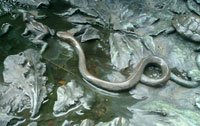 Due to our light pollution we can only see 150 out of 5000 stars with the naked eye today. To be able to view the sky "should be considered a fundamental socio-cultural and environmental right", according to the International Astronomical Union.
Due to our light pollution we can only see 150 out of 5000 stars with the naked eye today. To be able to view the sky "should be considered a fundamental socio-cultural and environmental right", according to the International Astronomical Union.Life evolved between heaven and earth. Ancient civilisations observed constellations in the sky with their naked eye for eons. Stargazing took place in ancient Egypt, Mesoamerican civilizations, Aboriginal Australia , the Pacific and many other places. The observation of natural phenomena shaped human society, their knowledge and the landscape. Astronomy and technology developed further thanks to a dark and observable sky.
After 'the candle' and gas, electrification illuminated the industrial world in the 19th Century to work 'around the clock'. Rapid urbanisation followed at lightning speed. Aggregations of people blocked the universe out to get on with business. Networked mega cities glow 24/7, illuminating the Earth. Speeding navigation in the sky, on the waters or on the terrestial zones relies on artificial 'stars' that guide us through augmented reality. Bright billboards inform us of our desires while drifting through light tunnels. Dwellings are show cased by bright lights, announcing their presence to the universe, or prospective buyers.
 More (of the same) is always better, so it is with light. Perception and orientation function better with more watts. No one wants to be kept in the dark. The absence of light is more concerning than the end of energy and water on the planet. Dark is just so dark.
More (of the same) is always better, so it is with light. Perception and orientation function better with more watts. No one wants to be kept in the dark. The absence of light is more concerning than the end of energy and water on the planet. Dark is just so dark.Ineffective lighting design and unnecessary illumination is wasting energy and water. Light pollution is also negatively affecting humans, flora and fauna.
 The legacy of a degraded sky is an irrevocable loss for living beings on earth. Future generations will be deprived of a social right of 'being in the universe' that all previous generations had enjoyed.
The legacy of a degraded sky is an irrevocable loss for living beings on earth. Future generations will be deprived of a social right of 'being in the universe' that all previous generations had enjoyed.More on
Light Pollution, delicious
More on Light pollution, Mnly Blog
Images:
Milky Way, via Zeno
Vincent Willem van Gogh, The Cafe Terrace, 1888, via Zeno
Vincent Willem van Gogh, Starry Night over the Rhone, with gas lighting, 1888 via Zeno









